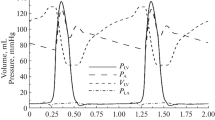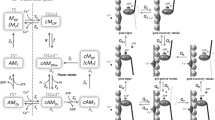Abstract
A contractile-based model was constructed to represent responses to changes in left ventricular (LV) volume in a heart with constantly activated myocardium. Hearts were isolated from rabbits, the myocardium was put into a state of constant activation by perfusion with Krebs Henseleit solution containing 0.5 mM Ba2+, and recordings were taken of LV pressure responses to step and sinusoidal changes in LV volume. Pressure responses to volume steps were divided into five characteristic phases. An elastance frequency spectrum was calculated from pressure responses to sinusoidal volume changes. Values of features of the elastance frequency spectrum were in accord with values of corresponding features of the step response. Using an explicit homology between elements responsible for LV pressure development (pressure generators) and elements responsible for muscle force development (myofilament cross-bridges), mathematical models were constructed to re-create the data. Basic assumptions were that (1) pressure was the summed effect of pressure generators undergoing volumetric distortion; (2) changes in volume brought about changes in both generator numbers (recruitment) and generator distortion; (3) pressure generators cycle through states that variously do and do not generate pressure. An initial two-step model included a cycle with one attachment step and one detachment step between non-pressure-bearing and pressure-bearing states. Predictions by the two-step model had many similarities with the experimental observations, but were lacking in some important respects. The two-step model was upgraded to a multiple-step model. In addition to multiple attachment and detachment steps within the cycle, the multiple-step model incorporated distortion-dependent detachment steps. The multiple-step model re-created all aspects of the experimentally observed step and frequency responses. Furthermore, this model was consistent with current theories of contractile processes.
Similar content being viewed by others
References
Arts, T., R. S. Reneman, and P. C. Veenstra. A model of the mechanics of the left ventricle.Ann. Biomed. Eng. 7: 299–318, 1979.
Berman, M. R., J. N. Peterson, D. T. Yue, and W. C. Hunter. Effect of isoproterenol on force transient time course and on stiffness spectra in rabbit papillary muscle in barium contracture.J. Mol. Cell. Cardiol. 20:415–426, 1988.
Brenner, B. Dynamic actin interaction of cross-bridges during force generation: Implications for cross-bridge action in muscle. In: Mechanisms of Myofilament Sliding in Muscle Contraction, edited by H. Sugi and G. H. Pollack. New York: Plenum Press, 1993, pp. 531–543.
Burton, K. Myosin step size: Estimates from motility assays and shortening muscle.J. Musc. Res. Cell Motil. 13:590–607, 1992.
Campbell, K.B., S. G. Shroff, and R. D. Krikpatrick. Short-time-scale left ventricular systolic dynamics. Evidence for a common mechanism in both left ventricular chamber and heart muscle dynamics.Circ. Res. 68:1532–1548, 1991.
Campbell, K. B., A. R. Rahimi, D. L. Bell, R. D. Kirkpatrick, and J. A. Ringo. Pressure response to quick volume changes in tetanized isolated ferret hearts.Am. J. Physiol. 257 (Heart Circ. Physiol. 26):H38-H46, 1989.
Campbell, K.B., H. Taheri, R. D. Kirkpatrick, and B. K. Slinker. Single perturbed beat vs steady-state beats for assessing systolic mechanical function in the heart.Am. J. Physiol. 262 (Heart Circ. Physiol. 31):H1631-H1639, 1992.
Campbell, K. B., R. D. Kirkpatrick, G. G. Knowlen, and J. A. Ringo. Late-systolic pumping properties of the left ventricle. Deviation from elastance-resistance behavior.Circ. Res. 66:218–233, 1990.
Campbell, K. B., J. A. Ringo, Y. Wakao, P. A. Klavano, and J. E. Alexander. Internal capacitance and resistance allow prediction of right ventricle outflow.Am. J. Physiol. 243 (Heart Circ. Physiol. 12):H99-H112, 1982.
Campbell, K. B., J. A. Ringo, G. G. Knowlen, R. D. Kirkpatrick, and S. L. Schmidt. Validation of optional elastance-resistance left ventricle pump models.Am. J. Physiol. 251 (Heart Circ. Physiol. 20):H382-H397, 1986.
Campbell, K. B., H. Taheri, R. D. Kirkpatrick, T. Burton, and W. C. Hunter. Similarities between dynamic elastance of left ventricular chamber and papillary muscle of rabbit heart.Am. J. Physiol. 264 (Heart Circ. Physiol. 33):H1926-H1941, 1993.
Campbell, K. B., R. D. Kirkpatrick, A. H. Tobias, H. Taheri, and S. G. Shroff. Series coupled non-contractile elements are functionally unimportant in the isolated heart.Cardiovasc. Res. 28:242–251, 1994.
de Tombe, P. P., and H. E. D. J. ter Keurs. An internal viscous element limits unloaded velocity of sarcomere shortening in rat myocardium.J. Physiol. 454:619–642, 1992.
de Tombe, P. P., and W. C. Little. Inotropic effects of ejection are myocardial properties.Am. J. Physiol. 266 (Heart Circ. Physiol. 35):H1202-H1213, 1994.
Elzinga, G., and N. Westerhof. Pressure-volume relations in isolated cat trabecula.Circ. Res. 49:388–394, 1981.
Fabiato, A., and F. Fabiato. Myofilament generated tension oscillations during partial calcium activation and activation dependence of the sarcomere length-tension relation of skinned cardiac cells.J. Gen. Physiol. 72:667–699, 1978.
Frank, O. Zur dynamik des herzmuskels.Zeitschrift Biologie 32:370–447, 1895.
Gupta, T., W. C. Hunter, and K. B. Campbell. Systolic shortening steps minimally alter subsequent force time course in rabbit myocardium.FASEB J. 5:A1395 1991.
Harada, Y., K. Sakurada, T. Aoki, D. D. Thomas, and T. Yanagida. Mechanochemical coupling in actomyosin energy transduction studied in in vitro movement assay.J. Mol. Biol. 216:49–68, 1990.
Hunter, W. C. End-systolic pressure as a balance between opposing effects of ejection.Circ. Res. 64:265–275, 1989.
Hunter, W. C., J. S. Janicki, K. T. Weber, and A. Noordergraaf. Systolic mechanical properties of the left ventricle: Effects of volume and contractile state.Circ. Res. 52: 319–327, 1983.
Huxley, A. F. Muscle structure and theories of contraction.Prog. Biophy. Chem. 7:255–318, 1957.
Huxley, A. F., and R. M. Simmons. Proposed mechanism of force generation in striated muscle.Nature 233:533–538, 1971.
Katz, A. M., and P. B. Katz. Homogeneity out of heterogeneity.Circulation 79:712–717, 1989.
Kirkpatrick R. D., K. B. Campbell, D. L. Bell, and H. Taheri. Method for studying arterial wave transmission effects on left ventricular function.Am. J. Physiol. 260 (Heart Circ. Physiol. 29):H1003-H1012, 1991.
Lakatta, E. G., M. C. Capogrossi, A. A. Kort, and M. D. Stern. Spontaneous myocardial calcium oscillations: Overview with emphasis on ryanodine and caffeine.Fed. Proc. 44:2977–2983, 1985.
Leijendekker, W. J., and J. W. Herzig. Reduction of myocardial cross-bridge turnover rate in presence of EMD 53998, a novel Ca2+-sensitizing agent.Pflügers Arch. 421: 388–390, 1992.
Lombardi, V., G. Piazzesi, and M. Linari. Rapid regeneration of the actin-myosin power stroke in contracting muscle.Nature 355:638–641, 1992.
Lymn, R. W., and E. W. Taylor. Mechanism of adenosine triphosphate hydrolysis by actomyosin.Biochemistry 10: 4617–4624, 1971.
Linke, W. A., M. L. Bartoo, and G. H. Pollack. Spontaneous sarcomeric oscillations at intermediate activation levels in single isolated cardiac myofibrils.Circ. Res. 73:724–734, 1993.
Lundblad, A., H. Gonzales-Serratos, G. Inesi, J. Swanson, and P. Paolini. Patterns of sarcomere activation, temperature dependence, and effect of ryanodine in chemically skinned cardiac fibers.J. Gen. Physiol. 87:885–905, 1986.
Mason, D. T., J. F. Spann, and R. Zelis. Quantification of the contractile state of the intact human heart.Am. J. Cardiol. 26:248–257, 1970.
Mulder, B. J. M., P. P. de Tombe, and H. E. D. J. ter Keurs. Spontaneous and propagated contractions in rat cardiac trabeculae.J. Gen. Physiol. 93:943–961, 1989.
Pate, E., and R. Cooke. A model of crossbridge action: The effects of ATP, ADP and Pi.J. Musc. Res. Cell Motil. 10:181–196, 1989.
Paulus, W. J., V. A. Claes, and D. L. Brutsaert. Physiological loading of isolated feline cardiac muscle. The interaction between muscle contraction and vascular impedance in the production of pressure and flow waves.Circ. Res. 44:491–497, 1979.
Prinzen, F. W., T. Arts, G. J. van der Vusse, W. A. Coumans, and R. S. Reneman. Gradients in fiber shortening and metabolism across ischemic left ventricular wall.Am. J. Physiol. 250 (Heart Circ. Physiol. 19):H255-H264, 1986.
Ringswandl, G., W. Motz, H. Meyrl, A. Schneider, K. Schwartz, and B. E. Strauer. Rapid transient analysis of myosin cross-bridge kinetics in hypertrophied hearts.Fed. Proc. 45:2585–2590, 1986.
Rodriquez, E. K., W. C. Hunter, M. J. Royce, M. K. Leppo, A. S. Douglas, and H. F. Weisman. A method to reconstruct myocardial sarcomere lengths and orientations at transmural sites in beating canine hearts.Am. J. Physiol. 263 (Heart Circ. Physiol 32):H293-H306, 1992.
Shibata, T., M. R. Berman, W. C. Hunter, and W. E. Jacobus. Metabolic and functional consequences of barium-induced contracture in rabbit myocardium.Am. J. Physiol. 259 (Heart Circ. Physiol. 28):H1566-H1574, 1990.
Shibata, T., W. C. Hunter, A. Young, and K. Sagawa. Dynamic stiffness measured in central segment of excised rabbit papillary muscles during barium contracture.Circ. Res. 60:756–769, 1987.
Shibata, T., W. C. Hunter, and K. Sagawa. Dynamic stiffness of barium-contractured cardiac muscles with different speeds of contraction.Circ. Res. 60:770–779, 1987.
Shroff, S. G., J. S. Janicki, and K. T. Weber. Left ventricular systolic dynamics in terms of its chamber mechanical properties.Am. J. Physiol. 245 (Heart Circ. Physiol. 14):H110-H124, 1983.
Shroff, S. G., J. S. Janicki, and K. T. Weber. Evidence of quantitation of left ventricle resistance.Am. J. Physiol. 249:H358-H370, 1985.
Shroff, S. G., K. B. Campbell, D. E. Miller, R. D. Kirkpatrick, and H. Taheri. Effect of temperature on short time scale left ventricular contractile dynamics.Circulation (Suppl I) 86:I-553, 1992.
Shroff, S. G., K. B. Campbell, and R. D. Kirkpatrick. Short time-scale systolic dynamics: Pressure versus volume clamps and effect of activation.Am. J. Physiol. 264 (Heart Circ. Physiol. 33):H946-H959, 1993.
Smith, D. A. Quantitative model for Schadler's isometric oscillations in insect flight and cardiac muscle.J. Musc. Res. Cell Motil. 12:455–465, 1991.
Sonnenblick, E. H. Implications of muscle mechanics in the heart.Fed. Proc. 21:975–990, 1962.
Steiger, G. J. Tension transients in extracted rabbit heart muscle preparations.J. Mol. Cell. Cardiol. 9:671–685, 1977.
Streeter, D. D., H. M. Spotnitz, D. P. Patel, J. Ross, and E. H. Sonnenblick. Fiber orientation in the canine left ventricle during diastole and systole.Circ. Res. 24:339–347, 1969.
Suga, H., and K. Sagawa. Instantaneous pressure-volume relationships and their relation in the excised, supported canine left ventricle.Circ. Res. 35:117–126, 1974.
Suga, H., L. Demer, and K. Sagawa. Determinants of instantaneous pressure in canine left ventricle.Circ. Res. 46: 314–322, 1980.
Vaartjes, S. R., and H. B. K. Boom. Left ventricular internal resistance and unloaded ejection flow assessed from pressure-flow relations: A flow-clamp study on isolated rabbit hearts.Circ. Res. 60:727–737, 1987.
van der Vusse, G. J., T. Arts, J. F. C., Glatz, and R. S. Reneman. Transmural differences in energy metabolism of the left ventricular myocardium: Fact or fiction.J. Mol. Cell. Cardiol. 22:23–37, 1990.
Woledge, R. C., N. A. Curtin, and E. Homsher.Energetic Aspects of Muscle Contraction. London: Academic Press, 1985, pp. 277–308.
Yanagida, T., T. Arata, and F. Oosawa. Sliding distance of actin filament induced by a myosin crossbridge during one ATP hydrolysis cycle.Nature 316:366–369, 1985.
Yanagida, T., Y. Harada, and T. Kodama. Chemomechanical coupling in actomyosin asystem: An approach by in vitro movement assay and kinetic analysis of ATP hydrolysis by shortening myofibrils.Adv. Biophys. 27:237–257, 1991.
Author information
Authors and Affiliations
Rights and permissions
About this article
Cite this article
Campbell, K.B., Campbell, L.W., Pinto, J.E. et al. Contractile-based model interpretation of pressure-volume dynamics in the constantly activated (Ba2+) isolated heart. Ann Biomed Eng 22, 550–567 (1994). https://doi.org/10.1007/BF02368284
Received:
Revised:
Accepted:
Issue Date:
DOI: https://doi.org/10.1007/BF02368284




